
views
Knowing Which Vaccines Your Kitten Needs and When
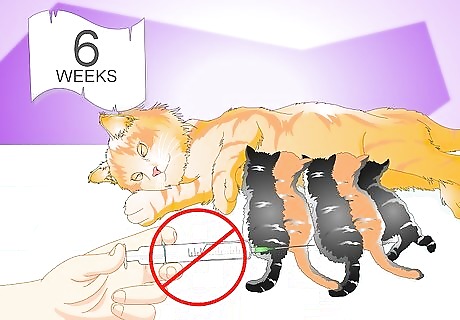
Avoid vaccines in the first six to eight weeks of life. When a kittens are born, and they start feeding from their mother, they ingest a variety of antibodies contained within their mother’s milk. These antibodies, in general, are able to protect the kitten while she grows and develops her own immune system, which will protect her from diseases. When the kitten is around six to eight weeks old, those antibodies tend to decrease within the kitten as she drinks less of her mother’s milk. It’s at this point that she needs help protecting her from infectious diseases with vaccines. One of the reasons it is not recommended to give a kitten a vaccine earlier than six to eight weeks is because those antibodies she’s receiving from her mother may actually interfere with the vaccine and prevent it from being effective.
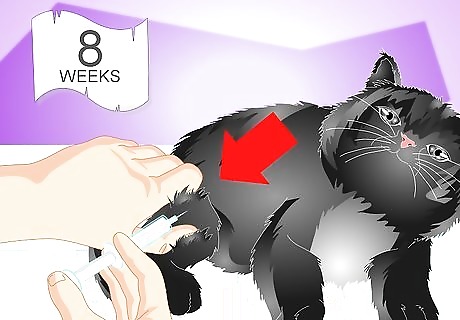
Begin vaccinating at six to eight weeks. Once a kitten is about six to eight weeks old he will need to start a series of vaccines in order to build-up his lifelong immunities to certain infectious diseases. The core vaccines recommended for kittens at this age include Feline Parvovirus (FPV), Feline Herpesvirus-1 (FHV-1), and Feline Calicivirus (FCV). Feline Parvovirus (FPV) may also be referred to as Feline Panleukopenia Virus or Feline Distemper. Feline Herpesvirus-1 (FHV-1) may also be referred to as Feline Rhinotracheitis Virus and is often associated with Feline Upper Respiratory Disease Complex. It is recommended that the modified live virus (MLV) version of all vaccines be used as they not only work faster, they last longer. Some veterinarians may be able to offer all three vaccines in one "combination" injection so your kitten will only require one needle. This is only possible when the vaccine is designed to be combined. Individual vaccines should never be combined into one injection otherwise.
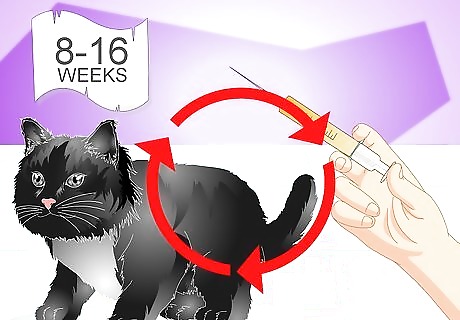
Continue to administer vaccines every two to four weeks weeks until your kitten is 16 weeks old. In general the three core feline vaccines should be administered to a kitten every two to four weeks between six to eight weeks of age and 16 weeks of age. The actual schedule you use may depend upon advice from your veterinarian, your kitten’s risk of exposure to certain diseases, and your schedule. If you start your kitten’s vaccines at six weeks of age and continue every two weeks, the schedule would be: six weeks, eight weeks, 10 weeks, 12 weeks, 14 weeks, and 16 weeks. If you start your kitten’s vaccines at six weeks of age and continue every four weeks, the schedule would be: six weeks, 10 weeks, 14 weeks, and 18 weeks. If you start your kitten’s vaccines at eight weeks of age and continue every two weeks, the schedule would be: eight weeks, 10 weeks, 12 weeks, 14 weeks, and 16 weeks. If you start your kitten’s vaccines at eight weeks of age and continue every four weeks, the schedule would be: eight weeks, 12 weeks, and 16 weeks.

Add the Feline Leukemia Virus (FeLV) vaccine at eight weeks old. Feline Leukemia Virus (FeLV) is considered a non-core vaccine, but is recommended for all kittens. FeLV can first be administered when your kitten is eight weeks old. She will need a second dose of the FeLV vaccine until three to four weeks later. The FeLV vaccine can only be given to kittens who do not have FeLV. In general a kitten should not have FeLV if her mother did not have it. However, if it is unknown whether the mother had FeLV it is recommended that she be tested first. Researchers are currently investigating the association of fibrosarcoma in cats who have received the FeLV vaccine. In a rare number of cases, a cat who has received the vaccine has developed fibrosarcoma in the area around the injection site. It is thought that these fibrosarcomas develop in cats who have been given the “dead" version of the vaccine (as opposed to the live version of the vaccine). Veterinarians normally inject the FeLV vaccine in a cat’s left rear leg, where no other vaccines are given, in order to allow the owner to recognize a tumor, should it develop.
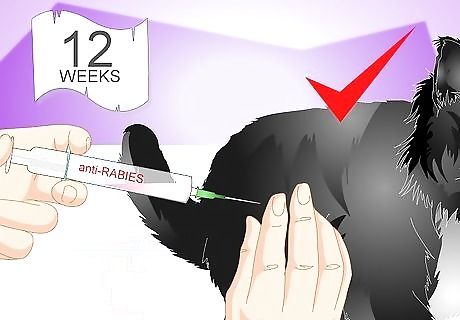
Administer the rabies vaccine as early as 12 weeks of age. The rabies vaccine is considered a core vaccine. Your kitten can receive her first rabies vaccine as early as 12 weeks old.

Talk to your veterinarian about the other non-core vaccines. Four additional vaccines are available for cats: Feline Immunodeficiency Virus (FIV), Chlamydia fells, Bordetella bronchiseptica, and Feline Infectious Peritonitis (FIP). All of these vaccines are considered non-core and their requirements for your kitten will depend on his individual circumstances. A vaccine for FIV is not normally recommended by veterinarians. However, if a kitten should receive this vaccine, for whatever reason, a careful record should be kept as future tests for FIV will likely be positive. Chlamydia felis is also known as Chlamydophila. The chlamydophila vaccine is normally only recommended for kittens who will be in multi-cat environments where the disease is already known. The Bordetella vaccine is normally only recommended for kittens who will be living in large, multi-cat environments or colonies. The vaccine for FIP is not normally recommended for kitten for any reason.
Administering Vaccines to Your Kitten

Keep calm and have help if you think you’ll need it. Depending on the personality of your kitten, and how hyper she is at any given moment, you may need to obtain assistance when giving her an injection. If this is your first time giving an injection, you may want someone else to hold your kitten so you can use both hands to administer the injection. Keeping calm during this procedure will also keep your kitten calm. You want to avoid associating stress with injections so your kitten doesn’t fear them in the future.
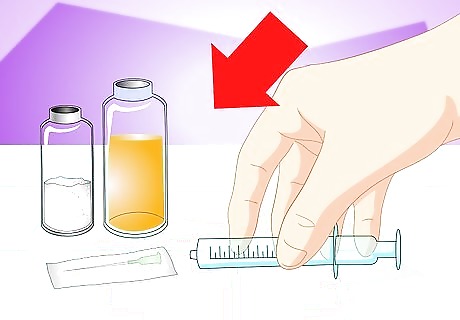
Ensure you have all the proper equipment. Depending on where you obtain the vaccine, it may not come with a syringe and needle. Make sure you have all the equipment you require before you start any attempt at vaccinating your kitten.
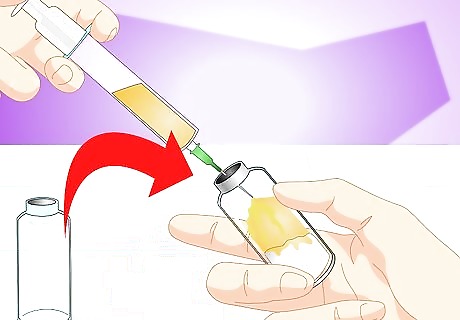
Mix the vaccine, if required. Some vaccines need to be mixed right before administration in order to activate the ingredients. Use these steps to mix-up the vaccine for your kitten: Attach the needle to the syringe, with the cap still on the needle. Remove the cap from the needle and insert the needle into the liquid vaccine vial. Turn the vial upside down and hold the syringe in a vertical position. Pull back on the plunger and fill the syringe with all of the liquid. Insert the needle into the second vial and press the plunger to inject the liquid from the first vial. The second vial normally contains a powder or a freeze-dried substance, as opposed to liquid. Take the needle out of the second vial and shake the vial thoroughly to mix the contents. Put the needle back into the second vial and pull back on the plunger to fill the syringe. Press the plunger to push out any excess air that may have accumulated in the syringe. Put the cap back on the needle until you’re ready to administer the vaccine to your kitten.

Fill the syringe with the vaccine. Before you attempt to restrain your kitten, get ready by filling the syringe with the vaccine. Attach the needle to the syringe (if it isn’t already), take off the needle cap, and insert the needle into the vaccine vial. Pull back on the plunger to fill the syringe with the vaccine. Squirt a little back out to ensure there are no air bubbles left in the syringe, then put the cap back on the needle till you’re ready to proceed.
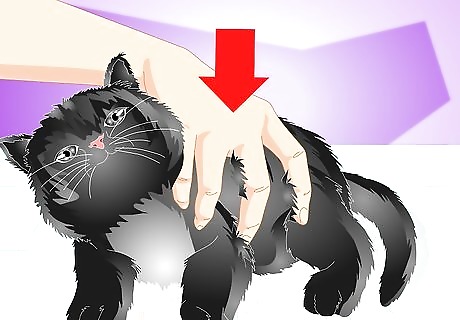
Restrain your kitten. You may find it easier to administer the vaccine while your kitten lies or sits in your lap. Alternatively you can place him on a table at a height that allows you to see and access the injection site properly. Use whatever position works best for your kitten and you. Whichever surface you end up using (your lap or a table) put down a towel or blanket first. This may be especially useful if you use your lap in case your kitten tries to scratch or bite you while you’re administering the vaccine. If you do not think you can restrain your kitten while administering the vaccine, have another person hold him in whatever position works best. This option will keep both of your hands free for the syringe.

Know where you need to inject the vaccine. Each vaccine will come with instructions on where it needs to be injected, and how it needs to be injected. If you are unsure of this information, contact your veterinarian for assistance. Combination vaccines, or the main core vaccines, are normally injected on the outside of your kitten’s right front leg, below the elbow joint. Any vaccines that contain a vaccine for FeLV must be injected into your kitten’s rear left leg on the outside of her body. Rabies vaccines (which can normally only be administered by a veterinarian) need to be injected on the outside of your kitten’s right rear leg.
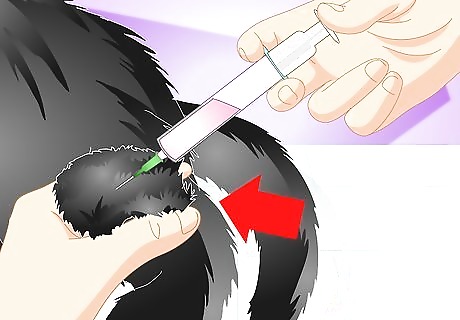
Inject a vaccine subcutaneously. Cat vaccines need to be injected subcutaneously, which means they’re injected right under the skin. To inject in a subcutaneous location, follow these steps: Locate the area where you will need to place the injection. Locate a spot with some loose skin. Gently pinch a bit of this skin with your thumb and finger and pull it outwards. Insert the needle into the tented part of the skin. Keep the needle parallel to the skin’s surface. You do not want to angle the needle downwards because you do not want to accidentally push the needle into a muscle, etc. Pull back on the plunger and check if any blood comes out. If not, you can proceed. If blood does come out, try another spot. Press the plunger of the syringe to inject the vaccine under the skin. Use a clean cloth or paper towel to dab any blood that may come out.
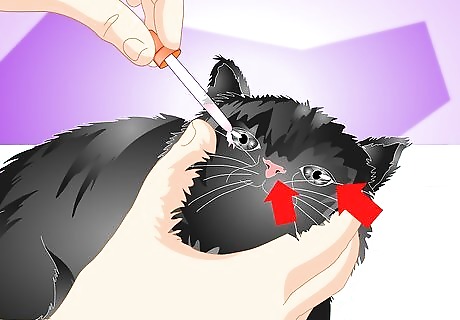
Give an intranasal vaccine. Some vaccines do not come in an injectable format, but rather in a liquid that needs to be dropped into your kitten’s eyes and nose. You will likely need to mix this type of vaccine before being able to administer it. Once the vaccine is mixed, use these steps to administer the vaccine: Place one drop of the vaccine in the corner of each of your kitten’s eyes. Squirt an equal amount of the remaining vaccine into each of your kitten’s nostrils.




















Comments
0 comment